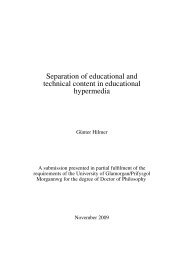framework for the implementation of a virtual design studio model in ...
framework for the implementation of a virtual design studio model in ...
framework for the implementation of a virtual design studio model in ...
Create successful ePaper yourself
Turn your PDF publications into a flip-book with our unique Google optimized e-Paper software.
approval. This view was expressed more clearly by older than by younger students.<br />
One can conclude that <strong>the</strong> older students believed that collaboration helps <strong>the</strong>m <strong>in</strong><br />
appreciat<strong>in</strong>g and understand<strong>in</strong>g <strong>the</strong> subject much better. Younger students did not<br />
express this idea with such clarity. Quite a number <strong>of</strong> times younger students mentioned<br />
that <strong>the</strong>y normally seek advice or discuss <strong>design</strong> problems with <strong>the</strong>ir friends or seniors.<br />
They <strong>in</strong>dicated that <strong>the</strong>y felt more com<strong>for</strong>table and achieved better understand<strong>in</strong>g<br />
when <strong>the</strong>y discussed <strong>design</strong> problems with <strong>the</strong>ir peers. It would thus seem that<br />
students, <strong>in</strong> general, were ready to adopt <strong>the</strong> social constructivist approach to learn<strong>in</strong>g<br />
<strong>the</strong> <strong>design</strong> subjects.<br />
Hands-on experience: Students <strong>in</strong> <strong>the</strong> third to fifth levels agreed that <strong>the</strong> <strong>model</strong>s which<br />
<strong>the</strong>y built were simple and unsophisticated at <strong>the</strong> beg<strong>in</strong>n<strong>in</strong>g, but with experience,<br />
support, and reflection, <strong>the</strong>y became <strong>in</strong>creas<strong>in</strong>gly complex. On <strong>the</strong> basis <strong>of</strong> this, <strong>the</strong>y<br />
argued that <strong>the</strong> tutors’ role should not be to do <strong>the</strong> job on <strong>the</strong>ir behalf, but ra<strong>the</strong>r to<br />
facilitate learn<strong>in</strong>g. They clearly <strong>in</strong>dicated that tutors should not only communicate <strong>the</strong><br />
important facts and concepts <strong>in</strong> <strong>the</strong> discipl<strong>in</strong>e but also, and more importantly, help <strong>in</strong><br />
bridg<strong>in</strong>g <strong>the</strong> gap between <strong>the</strong> structures <strong>of</strong> <strong>the</strong> discipl<strong>in</strong>e and <strong>the</strong> structures <strong>in</strong> <strong>the</strong>ir<br />
m<strong>in</strong>ds. These views are consistent with <strong>the</strong> cognitive learn<strong>in</strong>g <strong>the</strong>ory. Recent<br />
researches suggest that each person has a particular set <strong>of</strong> learn<strong>in</strong>g characteristics that<br />
determ<strong>in</strong>e <strong>the</strong> ways and means by which he/she learns. However, <strong>the</strong>se <strong>in</strong>nate learn<strong>in</strong>g<br />
preferences are almost immediately modified and developed by activity and experience.<br />
This cont<strong>in</strong>ues over time and <strong>in</strong> relationship to context, through <strong>the</strong> variety <strong>of</strong> learn<strong>in</strong>g<br />
experiences encountered (Wolf and Kolb, 1984). Learners <strong>in</strong>tegrate new ideas with<br />
prior knowledge <strong>in</strong> order to make sense or make mean<strong>in</strong>g or reconcile a discrepancy,<br />
curiosity, or puzzlement. They construct <strong>the</strong>ir own mean<strong>in</strong>g <strong>for</strong> different phenomena.<br />
For this reason, <strong>the</strong> tutor must engage students <strong>in</strong> active dialogue around learn<strong>in</strong>g and<br />
us<strong>in</strong>g learn<strong>in</strong>g materials. He/she must set a range <strong>of</strong> tasks and strategies which will<br />
facilitate and <strong>in</strong>volve students <strong>in</strong> active process<strong>in</strong>g (<strong>for</strong> example discussion, debate,<br />
question<strong>in</strong>g, expla<strong>in</strong><strong>in</strong>g) so that <strong>the</strong>y trans<strong>for</strong>m, translate and own <strong>the</strong> learn<strong>in</strong>g as<br />
personal knowledge<br />
Visualisation: Students <strong>in</strong> all levels emphasised that <strong>the</strong>y can understand and<br />
communicate <strong>in</strong> <strong>the</strong> <strong>design</strong> process better when visual aids are used. Many <strong>of</strong> <strong>the</strong>m<br />
commented on <strong>the</strong> current practice as:<br />
"very superficial" ...<br />
"lack <strong>of</strong> visuals"..<br />
"blurry and lack <strong>in</strong>-depth <strong>in</strong><strong>for</strong>mation"...<br />
"too much <strong>the</strong>ory... ".<br />
One <strong>of</strong> <strong>the</strong> level two students commented that:<br />
"I am not happy with <strong>the</strong> way we are taught here. I can't get <strong>the</strong> essence <strong>of</strong> learn<strong>in</strong>g<br />
construction [...] may be lack <strong>of</strong> visual contact as I learn faster (better) through visual,<br />
86



